Manakanda Giant taro (Alocasia) Uses, Research, Medicines, Side Effects
Manakanda – Alocasia indica is an Ayurvedic plant used for the treatment of diseases of vata roga, swelling, ear ache, bleeding and splenomegaly. It is also called Giant Taro and Mankand.
Latin name – Alocasia indica Schott
Family – Araceae(soorana kula)
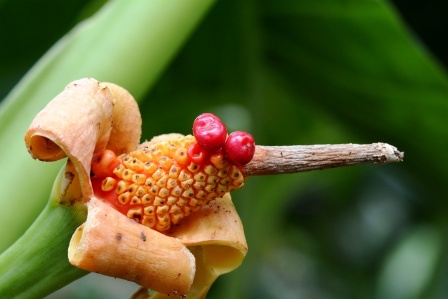
Table of Contents
Vernacular names
Names in different languages:
Hindi name – Manakand, Mankand
English name – Giant taro, Alocacia plant,
Assamese name – Boro mankachu
Bengali name – Mankachu
Gujarati name – Manakanda
Kannada name – Maanaka, Marasani, Marasakage,
Tamil name – Merukankilangu
Telugu name – Chara kanda , Sarachema
Marathi name – Mansachahu, Alu
Malayalam name – Marambu, Seema, Chembu, Venal chembu
Sanskrit synonyms
Sanskrit Synonyms of Manakanda:
Manaka – Its tuber attains a very big size.
Mahapatra – It has very big leaves.
Gajakarni – Its leaf resembles elephant ear in shape.
Sthala padma – It will have lotus like leaves and grows near water source
Manakanda, Manak, Deergadal, Mahacchada, Mahatpatra, Pankancha
Morphology
Morphology of Alocasia indica:
Manakanda is a herb which grows to a height of 3 – 6 feet. The stem is fleshy having 4 – 8 inch diameter. The large cordate leaves grow to a length of 20 to 90 cm on long petioles. Their araceous flowers grow at the end of a short stalk, but are not conspicuous; often hidden behind the leaf petioles.
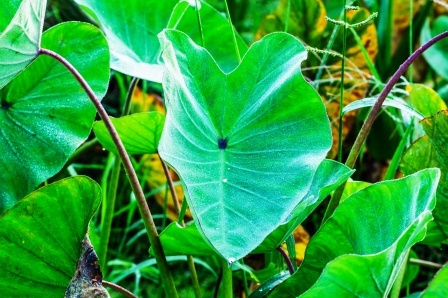
The flowers are yellow colored. The fruits are small, granular, red colored. The tuber is 1 – 2 feet long. The flowers are seen in the rainy season followed by the fruits. The plant is found all over India and cultivated especially in Bengal and Assam.
Properties, part used, dosage
Medicinal properties of Manakand:
Rasa (Taste) – Madhura (Sweet)
Guna (Qualities) – Guru (Heavy for digestion), Snigdha (Slimy in nature)
Vipaka – Madhura (Undergoes sweet taste after digestion)
Veerya (Potency) – Sheeta (Cold)
Karma (Actions) – Vatapitta shamaka (reduces vitiated vata and pitta dosha)
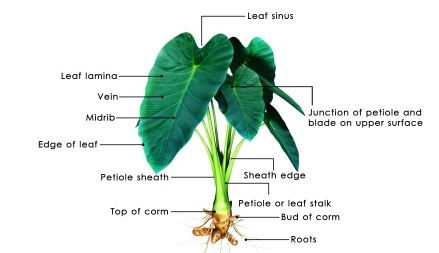
Part used – Rhizome, Stem, Leaf
Dosage –
Root powder – 5 to 10 g
Juice – 10 to 20 ml
Stalk and leaf juice- 12 to 24 ml
Leaves powder-5 to 10 g
Chemical composition
Chemical composition of Alocasia indica:
All parts of the plant, except tubers, contain cyanogenic principle, a mixture of triglochinin and iso – triglochinin. The tubers contain sterols and high concentration of soluble oxalates.
Medicinal uses
Medicinal Uses of Giant Taro:
- The leaf of manakanda is made into poultice and applied over joints affected with pain and swelling.
- The paste of the leaf is applied over the wound to control bleeding and reduce swelling.
- The powder of dried tuber of Alocasia indica is used in a dose of 3 – 5 g to treat splenomegaly.
- The powder of the dried tuber of manakanda is mixed with rice powder and milk and boiled. This mixture is given in the condition of swelling of the body (anasarca).
- The fresh juice of the leaf of Alocasia indica is slightly heated and used as drops to treat earache and reduce swelling.
- The tuber is used as a vegetable in different cuisines all over the country. Regular use of the tuber as a vegetable is advisable in conditions of piles and constipation.
Sanskrit verse
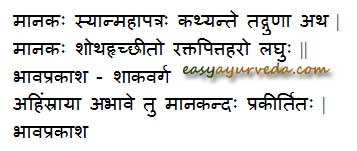
The stem and root stalk are edible, if boiled and washed thoroughly. It yields a pure white starch when the root is pulped and washed. The flour obtained is a light nutritious food, suitable for invalids. It is somewhat mucilaginous and is considered to be more easily digestible than rice.
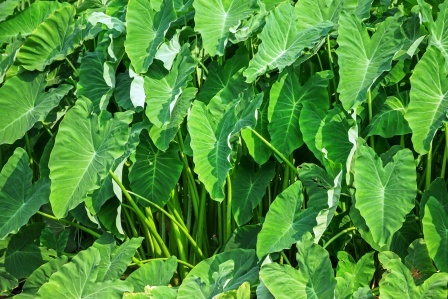
The ash of Manaka mixed with salt and oil should be rubbed on the tongue for removing palsy of tongue as incorporated by chakrapani, further Manaka stands as main component drug in two classical formulation namely Manaka payasa and Manakagrhta which have been indicated in management of udararoga and (abdominal diseases ) oedema (sotha) respectively. In addition Manakadya gutika has been recommended in treatment of liver and splenic disorders.
Side effects
Side Effects Of Alocacia plant:
The stem is edible, but contains Calcium oxalate along with other irritants that can numb and swell the tongue and pharynx resulting in difficult breathing, and sharp throat pain. The lower parts contain more of the poison. Prolonged boiling before serving or processing may reduce the risks but acidic fruit such as tamarind may dissolve them.
Interaction with medicines, supplements
Can this be used while taking Homeopathic medicine?
Yes. This product does not react with homeopathic medicine.
Can this medicine be continued while taking supplements like multivitamin tablets, Omega 3 fatty acids etc?
Yes. Generally, this product goes well with most dietary supplements. However, if you are taking more than one product per day, please consult your doctor for an opinion.
With western
medicines
Seek your
doctor’s advice if you are taking this product along with other western
(allopathic / modern) medicines. Some Ayurvedic herbs can interact with modern
medicine.
If both Ayurvedic and allopathic medicines are advised together, then it is
best to take Allopathic medicine first, wait for 30 minutes and then take the
Ayurvedic medicine.
Ayurvedic medicines
Ayurvedic medicines containing Manakanda:
Shothari mandura: It is an Ayurvedic medicine in tablet form, used in the treatment of edema and inflammatory conditions.
Research
Research articles related to Alocasia indica:
Action against hepato – toxicity: The possible protective role of ethanolic extract of A. indica tuber (EEAIT) in hepatotoxicity and apoptosis of liver caused by alcohol in rats was investigated. Treatment of rats with alcohol (3 g ethanol per kg body weight per day for 15 days intraperitoneally) produced marked elevation of liver biomarkers such as serum alanine aminotransferase (ALT), aspartate aminotransferase (AST), γ – glutamyl transpeptidase (γ – GT), and total bilirubin levels which were reduced by EEAIT in a dose – dependent manner. Furthermore, EEAIT improves antioxidant status (MDA, NO, and GSH) and preserves hepatic cell architecture. Simultaneous supplementation with EEAIT significantly restored hepatic catalase (CAT) and superoxide dismutase (SOD) activity levels towards normal.
Anti – diabetic action: The present study was designed to investigate antidiabetic & hypolipidemic potential of alcoholic extract of Alocasia indica Schott. leaves (Araceae) in streptozotocin induced diabetic rats. Blood glucose levels & body weight was monitored at specific intervals and lipid profile parameters such as serum cholesterol, serum triglyceride & high density lipoprotein (HDL) were also assessed in experimental animals. The statistical data indicated significant increase in body weight & decrease in blood glucose level & serum lipid profiles (cholesterol & triglyceride) in test extract treated animals. These results could explain the basis for the use of this plant extract to manage serum glucose level and lipidemia associated with diabetes mellitus.
Anthelmintic action:The present study was designed to evaluate the anthelmintic activity of Alocasia indica Schott. root stocks using specific in vitro standard procedures. Time of paralysis and time of death of earthworms were considered as the parameters to assess the anthelmintic action. The ethyl acetate fraction of alcoholic extract exhibited significant anthelmintic activity compared to alcoholic extract as evidenced by significant decrease in time of paralysis & death. The observed activity could be due to the presence of phenolic compounds, particularly flavonoids in the test extract.
Anti – oxidant activity:The present study was designed to evaluate free radical scavenging activity of Alocasia indica Schott. root stocks using specific in vitro standard procedures. Ethyl acetate, butanol and aqueous fractions derived from total methanolic extract of Alocasia indica Schott. Rootstocks were evaluated for radical scavenging activities using different in vitro models like scavenging of 2,2 diphenyl – 1 – picrylhydrazyl (DPPH) radicals, superoxide anion radical nitric oxide radical scavenging activity. These in vitro studies indicated Alocasia indica Schott.rootstocks extracts are a significant source of natural antioxidants.
Classical categorization
Bhavaprakasha – Shaka varga
Scientific classification
Kingdom: Plantae
Order: Alismatales
Family: Araceae
Subfamily: Aroideae
Tribe: Colocasieae
Genus: Alocasi
Distribution, collection, preservation
Distribution: All over India, specially in Bihar and Bengal.
Collection and preservation:
It blossoms in the rainy season followed by fruiting.
On the hills, they should be grown under glazed shelter where as in the plant a glass conservatory is suitable.
For preserving it for a long time it should be dried and stored under air –tight pot.
Author: Dr.B.K.Prashanth M.D (Ayu), Ph.D
E mail: [email protected]
Click to consult Dr Prashanth BK
Sthanika Karma (Systemic Action)
External Application: Leaf and tuber is made in to paste and tied on inflammatory joints. The fresh juice of the leaf of Alocasia indica is slightly heated and used as drops to treat earache and reduce swelling. The ash of Manaka mixed with salt and mustard oil should be rubbed on the tongue in palsy of tongue
Internal administration-
Nervous system – Pacifies vata dosha. Indicated in vataja rogas.
Digestive System – facilitates movement of doshas in normal direction, indicated in Abdominal colic. Indicated in Abdominal cramp, Constipation, Hemorrhoids etc.
Circulatory System – Leaf juice is indicated in Bleeding disorders. Powder of the tuber and a special preparation called Manamanda is indicated in oedema. It is also beneficial in Splenomegaly.
Excretory System – Mutrajanana , indicated in dysuria
Satmikarana – Indicated in Anemia, general debility etc.









